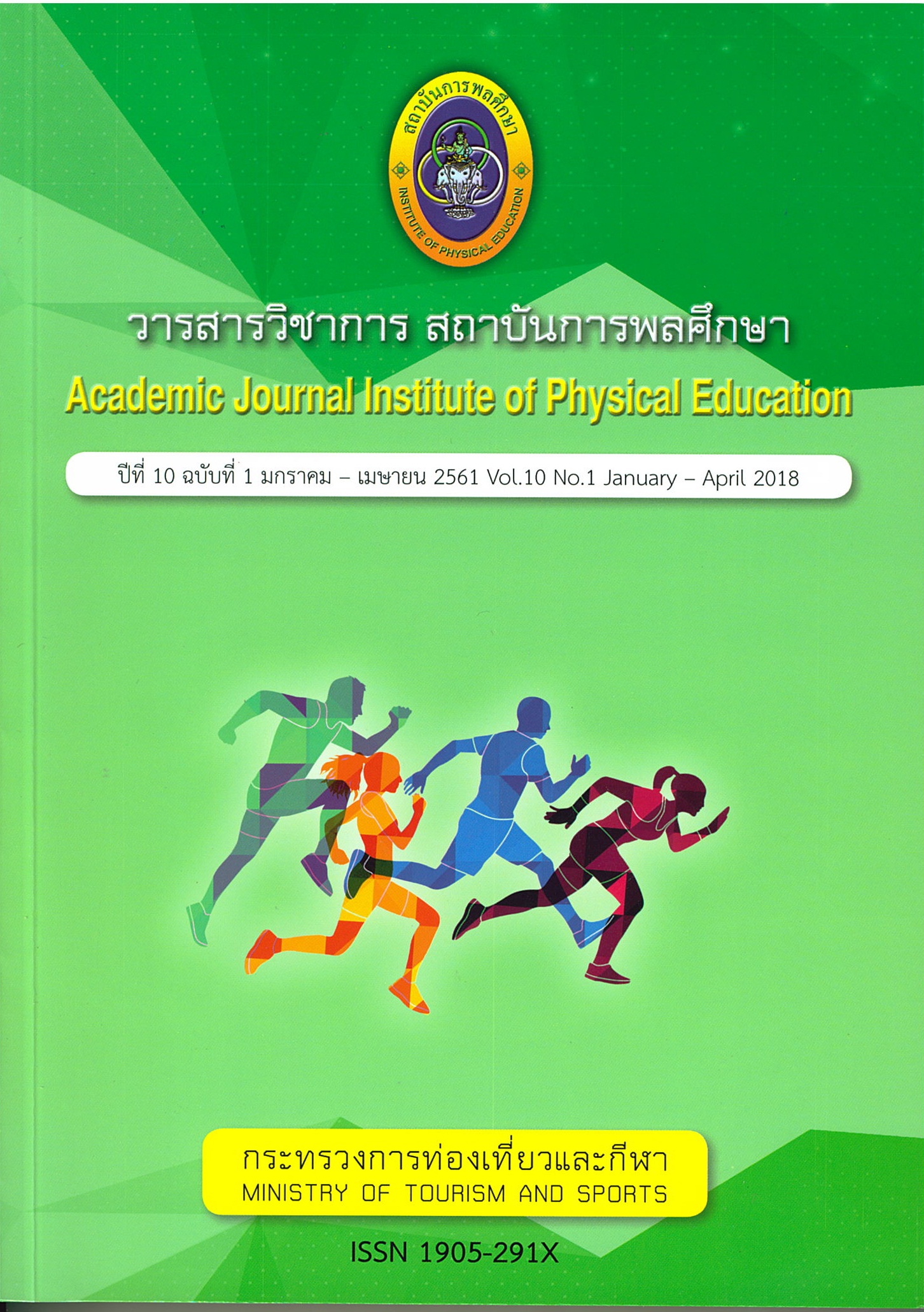The indicatorsdevelopment of learning community in Institute of Physical Education
Main Article Content
Abstract
The objectives of this research were 1) to develop main components, subcomponents and indicators of Institute of Physical Education Learning Community and 2) to test consistency of the Structural Model of Indicators for Institute of Physical Education Learning Community with the empirical data. The research sample consisted of 402 administrators, lecturers and employees of Institute of Physical Education. They were selected by stratified random sampling. The instruments of this research were interview form and rating scale questionnaire with the validity value at 0.85. The data was analyzed by basic statistics. The confirmatory factor analysis was analyzed by Structural Equation Modeling (SEM) using LISREL program. The consistency of the developed model and the empirical data was tested. The results were as follows:
1) Institute of Physical Education Learning Community consisted of 4 main components, 12 subcomponents and 99 indicators. The first main component was wholeness, consisting of 3 subcomponents with a total of 23 indicators including 1) integration (8 indicators), 2) oneness (8 indicators) and 3) identity (7 indicators). The second main component was professional community, consisting of 3 subcomponents with a total of 34 indicators including 1) organizational culture (13 indicators), 2) collaboration (8 indicators) and 3) transformation (13 indicators). The third main component was ethics, consisting of 3 subcomponents with a total of 22 indicators including 1) fairness (7 indicators), 2) honest (8 indicators) and 3) virtue (7 indicators). The fourth main component was credibility, consisting of 3 subcomponents with a total of 20 indicators including 1) expertise (6 indicators), 2) trust (8 indicators) and 3) dynamism (6 indicators).
2) The developed Structural Model of Indicators for Institute of Physical Education Learning Community was consistent with the empirical data as follows: c2 = 58.63, df = 39, , c2/df = 1.50, GFI = 0.98, AGFI = 0.95, CFI = 1.00, SRMR = 0.013, RMSEA = 0.035, and Critical N = 431.86.
Article Details
The published article is a copyright of the Academic Journal of Thailand National Sports University. The passage appeared in each article in this academic journal is a perspective of each author which is not related to the journal. Each author is required to be responsible for all components of his/her own article. If there are any mistakes, each author must be responsible for those mistakes on his/her own.
References
พระธรรมปิฎก(ป.อ.ปยุตฺโต). (2550). พจนานุกรมพุทธศาสตร์ฉบับประมวลศัพท์. กรุงเทพมหานคร : มหาจุฬาลงกรณราชวิทยาลัย.
สถาบันการพลศึกษา. (2559). ยุทธศาสตร์สถาบันการพลศึกษา พ.ศ. 2556-2560 (ฉบับปรับปรุง).ค้นเมื่อ 13 ธันวาคม 2559, จาก http://www.ipecm.ac.th/plan/ยุทธศาสตร์สถาบันฯ 2556-2560 ประจำปีงบประมาณ 2559.pdf
สัมฤทธิ์ กางเพ็ง และศรายุทธ กันหลง. (2553). ภาวะผู้นำใฝ่บริการในองค์การ: แนวคิด หลักการทฤษฎีและงานวิจัย. พิมพ์ครั้งที่ 2. ขอนแก่น: คลังนานาวิทยา.
สุภมาส อังศุโชติ, สมถวิล วิจิตรวรรณา และรัชนีกูล ภิญโญภานุวัฒน์. (2551). สถิติวิเคราะห์สำหรับ
การวิจัยทางสังคมศาสตร์และพฤติกรรมศาสตร์: เทคนิคการใช้โปรแกรม LISREL. กรุงเทพฯ: มิสชั่นมีเดีย.
Bentley, S. (1998). Building an effective high school: A descriptive study. Unpublished doctoral dissertation, Pepperdine University, CA: Malibu.
Berman, E. G. (1983). Symbolic convergence: Organization communication and culture. Beverly Hill, CA: SAGE.
Blank, M. J. (2001). Education reform: The community schools approach. Unpublished manuscript, Institute for Educational Leadership, Washington, DC.
Frese, M. (2000). Success and failure of microbusiness owners in Africa. Westport, CT: Greenwood Publishing, Inc.
Hair Jr, William C. Black, Barry J. Babin, Rolph E. Anderson. (2006). Multivariate data analysis. Upper Saddle River, N.J.: Pearson/Prentice Hall.
Hiatt-Michael, D. (2001). Schools as Learning Communities: A Vision for Organic School Reform. Unpublished manuscript, Pepperdine University, CA: Malibu
Merriam, S., & Caffarella, R. S. (1999). Learning in adulthood (2nd ed.). San Francisco: Jossey-Bass.
Robbins, S.P. (2001). Organizational behavior. 9th ed. Prentice–Hall.
Russell, R.F. (2001). The role of values in servant leadership. Leadership & Organization Development Journal, 22(2), 76-83.
Schroeder, P. (2001). Networks as Learning Communities: Shaping the Future of Teacher Development, Journal of Teacher Education, 25(51), 221.
Sergiovanni, T. J. (1994). Building community in schools. San Francisco: Jossey- Bass.
Swanson, A.D., (2000). Fundamental Concepts of Education Leadership. 2nd ed., New Jersey: Merrill Prentice-Hall.


